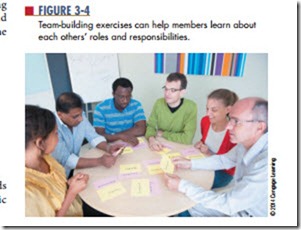teamwork
A team has more than one person, with each team member having different responsibilities. The team working toward a common goal is referred to as teamwork.
A challenge of teamwork is to get the team members to become comfortable enough with each other to work together. It requires team members working with each other to learn their jobs (Figure 3-4).
An electronics project requires each team member to be assigned a specific task that he or she is respon- sible for completing. With multiple tasks, each team member might have more than one team assignment. Task assignments and roles for the fabrication of a printed circuit board (PCB) could be set up like this:
● Team Leader: In many ways, the team leader is the anchor for the team. The position brings a high level of responsibility. The team leader is the best person to help the team fulfill its objectives. A strong leadership leads to better teamwork. The team leader’s duties include
the following:
● Acts as the liaison between the instructor and the team
● Is responsible for making sure resources are available
● Helps the team plan daily what is to be accomplished
● Motivates the team with clear communications
● Is responsible for keeping the team on task and for everything related to and done by the team
● Serves the group, but does not control or domi- nate it
● Computer Simulator: This person verifies that the circuit design is valid by using an electronic simulation program and confirms the circuit does what it is designed to do. The computer simulator’s responsibilities include these:
● Inputs the circuit into an electronic simulation program
● Confirms that the circuit does what it is designed to do
● Verifies the components’ values
● PCB Designer: Using the schematic diagram, the PCB designer develops the PCB layout once the computer simulator verifies the circuit. The PCB designer’s duties are listed here:
● Is responsible for obtaining all the components for the PCB
● Uses the components to make paper dolls
● Uses the paper dolls to lay out the top of the PCB
● Routes the traces on the copper side of the PCB
● PCB Fabricator: Using the layout designed by the PCB designer, the PCB fabricator fabricates the PCB and is responsible for the following tasks:
● Transfers the layout design to a copper-clad board
● Etches the copper-clad board
● Cleans the PCB and drills all holes
● Verifies that the PCB is complete
● Assembler: Using the etched PCB and the com- ponents used by the PCB designer, the assembler completes the PCB. The assembler’s tasks include these:
● Installs components into the PCB in a logical pattern
● Solders and trims all component leads to the PCB
● Inspects the completed board
● Tests the completed board
● Troubleshoots the PCB if necessary
● Recorder: This individual provides the documentation necessary at all steps of the PCB fabrication. He or she is responsible for providing any information needed,
as outlined here:
● Works with each team member to have accurate daily logs
● Maintains a folder to provide feedback to the team
● Provides information during daily planning
● Media Presentation: This person documents daily activities using a camera, video camera, and daily notes in order to prepare a media presentation such as PowerPoint, video, or audio. The media presenter’s duties follow:
● Is responsible for capturing all the moments of the team
● Develops a meaningful presentation for the class
● Actively involves all team members in the presentation
● Provides a chronological order to the presentation
● Is able to explain how the project works
Working on teams can be difficult and frustrating. Poor communications by team members can lead to confusion or misunderstanding. Both the team members and team leader need to effectively communicate to create a successful team.
Techniques to become a better team member:
● Accept responsibility: People in a group tend to lose respect for an individual who is constantly blaming others for not meeting deadlines. Team members know who is not pulling his or her weight on the team. Encourage nonsupporting team members to get their tasks completed.
● Be a team member: Don’t act like a know-it-all and burden the team by fishing for compliments every time a task is completed. Doing this creates tension within the group. The team will recognize when good work is being done, and they’ll let it be known.
● Communicate: If a problem exists with someone in the group, talk to that person about it. Do not let bad feelings grow, as they will make team members uncomfortable and make them want to isolate themselves from the group.
● Get involved: Share ideas, suggestions, solutions, and proposals with team members.
● Listen actively: Respect the person speaking, ask probing questions, and acknowledge what’s said by repeating points that have been made. If some-
thing is unclear, ask for more information to clarify any confusion before moving on. Listening is a vital activity of any team and is the other half of communication.
● Support the team: Keep an open mind when a team member suggests an idea; respond positively, and consider the idea. Considering the team member’s ideas shows an interest in all ideas.
Questions
1. What is the definition of teamwork?
2. What is a challenge of teamwork?
3. What are the task assignments for building an electronics project?
4. What is one of the major problems with teamwork?
5. What are the techniques to become a better team member?
